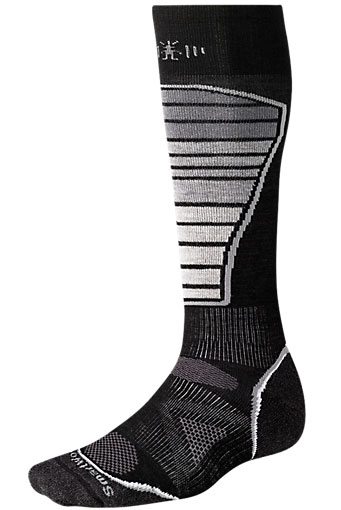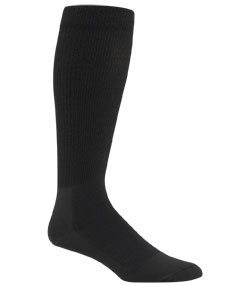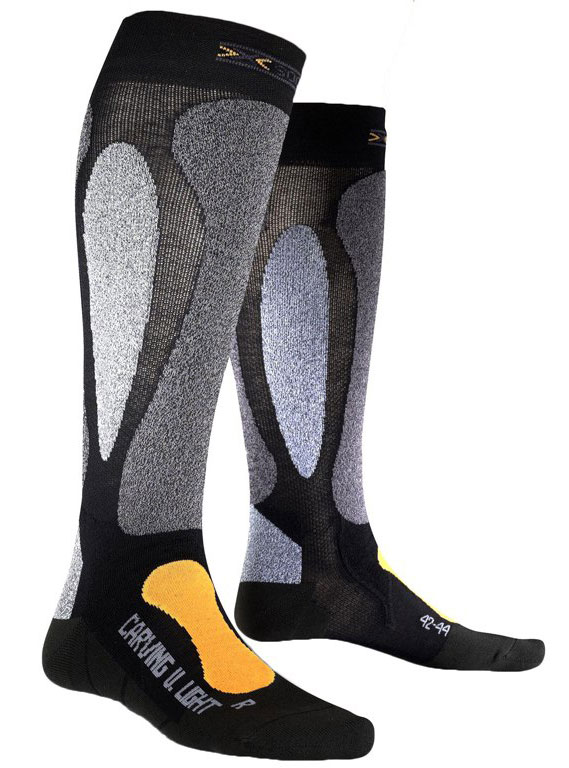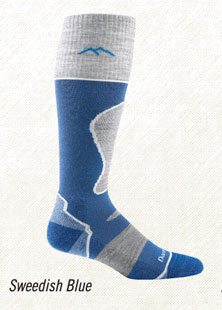It’s time to talk socks. But rather than offer a primer on what you ought to be wearing when you go ski or snowboard, we decided to ask a number of our reviewers to see what they actually wear on the mountain, and why.
Some of us care a lot about socks; others, not so much. But there are two primary bits of conventional wisdom when it comes to socks and snowsports:
(1) Don’t be wearing no cotton—cotton socks don’t wick well. You’re feet will get sweaty, your socks will get wet, and you’ll freeze.
(2) Thinner is better. I’ve yet to meet a bootfitter who disagrees, but as you’ll see, not all of our reviewers abide by this, and you can decide whether they make a persuasive case or not.
Take a look:
SKI SOCKS
 Morgan Sweeney: SmartWool PhD Ski Light
Morgan Sweeney: SmartWool PhD Ski Light
My go-to ski sock would have to be SmartWool, hands down. SmartWool offers five different socks on their women’s snow sport line that are either ski or snowboard specific, ranging from light to medium weight. After sporting a variety of women’s socks they offer, the PhD Ski Light remains at the top of my list. Unlike their heaviest sock, the PhD Ski Light has padding only on the shin and heel, and light padding at that. This particular design keeps my heel in place and saves my shins from the unfortunate shinbang.
Skiers often reach for the thickest socks possible so they can avoid trips to the warming hut, but I think it’s also important to consider the sock’s overall design. The thin, elastic material of the PhD Ski Light is less prone to bunching up in my boot and easily wicks away sweat from my feet, keeping them at a comfortable temperature. Though SmartWool’s PhD Ski Light may not be the warmest sock on the market, it is certainly the most comfortable and functional sock I’ve slipped on yet.
 Andrew Gregovich: Wigwam Ultimax Snow Whisper Pro
Andrew Gregovich: Wigwam Ultimax Snow Whisper Pro
My ski socks are cheap and simple, and my favorite pairs are made by Wigwam. Not coincidentally, they are the thinnest and smoothest feeling pairs I own.
The pairs I currently use the most have seen four or five seasons. They have a few holes, but I will continue to use them until my toes start poking through. I have also used thin SmartWool socks in the past, but they didn’t hold up as well as my Wigwams.
Marshal Olson: Wigwam Ultimax Snow Whisper Pro
I have used these socks for at least five years. They are not funky, they have no holes. They have hundreds of days of use. They are thin and allow great blood flow; they wick well (but not quite as well as wool); and they last. I have used Icebreaker, SmartWool, and Bridgedale micro wool socks, and they are super nice, but I cannot stomach throwing away $25 wool socks every few months because of holes in the socks or a torn upper cuff.
My one gripe with the Wigwams is that there are vertical ribs in the shin, and I do prefer a smooth shin, but this is super minor, and, all in all, I prefer the durability.
 Emily Cleveland: X Socks Ski Carving Ultralight
Emily Cleveland: X Socks Ski Carving Ultralight
I prefer a thin sock that allows me not to lose any feeling for my skis. In addition, thin socks allow me to have a really snug boot fit. The women’s Ski Carving Ultralight sock made by X Socks combines thin, high-tech fibers with anatomically adapted padding to maximize energy transmission and regulate temperature. Features such as the “X-Cross Bandage” and the “Traverse AirFlow Channel System” provide comfort, support, cooling, and warmth all at once.
In addition to merino wool and Robur, X Socks are made with Mythlan, which prevents the growth of odor and bacteria. I’m usually skiing everyday, and its often difficult to find a pair of clean socks. With X Socks, I can literally wash my socks once a month and still not scare people off with reeking boots. They are more expensive than your basic ski sock ($55), but you really need only one or two pairs, and you’re set. In my opinion, there is nothing better than X Socks.
 Lexi Dowdall: Darn Tough Merino Wool Over-The-Calf Padded Cushion Ski Sock
Lexi Dowdall: Darn Tough Merino Wool Over-The-Calf Padded Cushion Ski Sock
My boyfriend (a snowboarder) and I have both loved the durability and comfort of the Darn Tough brand over the years. Because it is an organic material, merino wool naturally tends to break down and wear out before synthetic socks do, but I’ve had great success with the Darn Tough brand. These socks are my particular favorite thanks to the plush comfort of added padding in the shin, heel, and toe areas. Thin socks have never worked well for me, and I appreciate the additional insulation provided by the cushioning. I even used these socks at Alta last week in temps hovering around 8 degrees Fahrenheit. While my toes did get cold, I shudder to imagine how much worse it could have been had I not been wearing these, my warmest pair.
Merino is also an excellent choice in that it resists bacterial odor. I’ve been known to wear my merino socks up to five ski days in between washings. (Just please don’t tell my mother that, she would be ashamed of my domestic skills). Another neat thing I love about the merino wool is that the wool fabric continues to insulate your feet even if it gets wet; it does this far better than any synthetic blend I’ve tried.
EURO Socks Sweet Silver Ski Sock
Bang for buck, these are my second favorite after the Darn Tough Padded Cushion Ski Sock. These haven’t demonstrated quite the durability of the Darn Tough pair, and I’m seeing some pilling of the fabric in both the heel and shin. These are a really breathable option that I use on warmer days. The fabric is about half as thick as the Darn Tough Cushion sock and features multiple vent channels to increase air flow. I do try to avoid using these socks when the temps dip below 30. These socks also feature cushioning in the shin, heel, and forefoot, though it isn’t as plush as the Darn Tough Cushion Sock. I do like the seams on the toe of the sock, they are very subtle and can not be easily detected. These socks also feature silver ions, which help to fight odor, but I do think that in the long run, merino fights odor more efficiently and the performance of the odor resisting silver ions decreases over time.

For what it’s worth, I openly admit to having pretty sweaty feet even when not working up a sweat. My feet have never felt drier throughout the day than when wearing Icebreakers. Warm is good – and they are that – but dry is key to daylong comfort.
I am disappointed that no one mentioned point 6 they are by far and away my favorite.
Point 6 is on our radar, Spencer, and we’ll hopefully be able to weigh in soon on how they stack up against some of our go-to products named above.